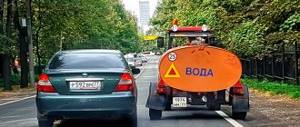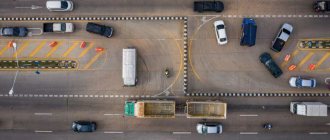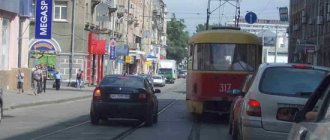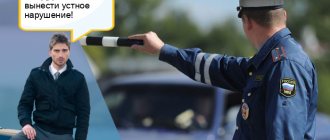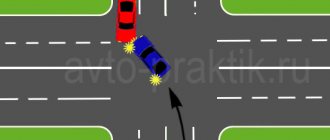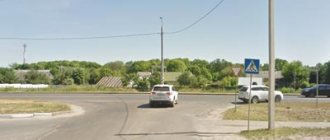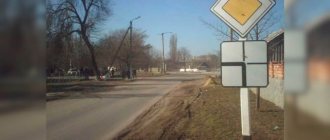What does the traffic regulations say?
According to traffic rules, this maneuver is permitted. This is directly stated in paragraph 9.2. According to it, on four-lane (or more) roads it is prohibited to enter the oncoming lane to advance, but at the same time, U-turns and left turns can be made both at intersections and in other areas where this action is not prohibited by signs or markings.
This rule is indirectly confirmed by clause 8.8. According to it, when changing direction outside the intersection, the driver is obliged to let all cars and trams from the oncoming traffic pass. That is, the implementation of this action is possible if all conditions are met.
The rules state that when performing such a maneuver, the driver must position the vehicle in the extreme left lane, and if the roadway is not wide enough, use the right lanes and even the shoulder.
Based on the listed traffic rules requirements, a U-turn outside the intersection is permitted provided there are no restrictions from road markings and installed signs. Exceptions are places specified in the Rules.
Areas where this maneuver is strictly prohibited include:
- zebra crossings;
- tunnels and bridges;
- railway crossings;
- sections of the roadway with limited visibility;
- public transport stops;
- highways, outside areas specially equipped for this.
U-turn at an intersection with explanations
So, the task has been set and the white car needs to make a U-turn at the intersection without violating traffic regulations.
Note. At the intersection considered as an example, horizontal road markings are clearly visible, but at a real intersection, the markings may be partially or completely erased. This makes things a little more difficult for the driver.
So, at the intersection there is one intersection of roadways, and here are its boundaries:
Let us turn to paragraph 8.6 of the traffic rules:
8.6. The turn must be carried out in such a way that when leaving the intersection of roadways the vehicle does not end up on the side of oncoming traffic.
Optimal turning trajectory at an intersection
The optimal turning trajectory should be in such a way that the car does not leave the intersection of roadways before the intended location:
This figure shows only 2 possible correct turning trajectories, but in practice you can turn along any trajectory lying between these two. Since the car does not leave the intersection of roadways, the driver does not violate the rules and no penalty can be imposed.
Incorrect turning trajectories at an intersection
Let's look at a few wrong trajectories, a reversal along which can lead to serious punishment:
So, in the above picture, both drivers were unable to make a U-turn within the intersection of roadways, so they had to drive a little onto the road adjacent from above.
At the same time, the driver who chose the right trajectory, when leaving the intersection of roadways, found himself in the lane in the same direction. However, then, continuing the started turn, he allows the intersection of the double solid marking line. If the intersection occurs perpendicular to the marking line, then the violation cannot be qualified as entering the oncoming lane. The punishment for the violator is a fine of 1,000 - 1,500 rubles under Part 2 of Article 12.16 of the Administrative Code.
As for the driver who chose the left trajectory, his situation is much worse. He leaves the intersection of roadways directly into the oncoming lane and his punishment will be a fine of 5,000 rubles or deprivation of rights for a period of 4 to 6 months (Part 4 of Article 12.15 of the Administrative Code). And in case of repeated violation - deprivation of rights for 1 year.
Fine for driving into oncoming traffic
Pay attention to the second maneuver, for which deprivation of rights is possible. Most drivers who read the traffic rules have no idea about this development of events and traffic police officers actively take advantage of this.
Let's look at how you can reduce the penalty if the reversal is unsuccessful :
1. Always start your turn on a long trajectory. If you can’t “fit in”, then simply refuse to make a U-turn and continue moving along the road you are crossing (up in the picture).
2. If you start making a turn along a small trajectory and feel that you won’t be able to “fit in”, then use reverse gear. Naturally, reversing at an intersection is prohibited, but the fine for such a maneuver will be only 500 rubles .
Of course, you need to carefully monitor other road users so as not to provoke an accident.
What is the procedure for performing the maneuver
To change direction outside the intersection of roadways, the driver must ensure that the following conditions are present:
- Lack of a continuous marking line. Its presence indicates the impossibility of entering the oncoming lane.
- There is no “No U-Turn” road sign, or make sure that its coverage area has already ended.
- There is sufficient space to perform the maneuver. In this case, you can make a U-turn from any convenient point on the road, unless otherwise specified by markings or signs.
- Possibility of reversing. This option is acceptable on narrow roads, when even turning the steering wheel a full 180 degrees, it will not be possible to complete the maneuver. In such a situation, the driver can back up a little, free up space for maneuvering and complete the intended action.
After all the described conditions are assessed by the driver, he can take a comfortable position, let oncoming (and sometimes passing) traffic pass and perform a U-turn in one or more actions.
Where you can and cannot turn around
Even in the absence of prohibitory markings or road signs, maneuvering outside the intersection is strictly prohibited in the following areas:
- at a pedestrian crossing marked with a sign or zebra crossing. To perform the action you will have to drive 20-30 meters further;
- on sections of the roadway where visibility is limited. It can be affected by the presence of a sharp turn, bend or rise. As a rule, such places are marked with a corresponding sign;
- at a public transport stop. This means that you can make a U-turn only from the far left lane, without using the stop “pocket” for this;
- if there are signs “Move straight” or “Move right”;
- on all structures (bridges, overpasses, dams) and in the railway crossing area.
On all other sections of the roadway, outside intersections, changing direction is permitted.
Rules for turning at intersections
The sequence of actions in this case is strictly regulated and cannot be violated. You can start turning only after occupying the leftmost lane. This rule can be omitted if the dimensions of your car do not allow it to be fulfilled. Make sure you are not creating an emergency or being a nuisance.
Compliance with the following conditions is mandatory:
- You cannot go beyond the intersection;
- You cannot drive into the oncoming lane;
- you need to fit into your lane;
- It is forbidden to cross a double solid line (read more about the fine for crossing a solid line);
- let all cars from other directions pass when you enter the middle of the intersection if they have the right of way ahead of you.
U-turn trajectories
You can make a U-turn at an intersection along two trajectories – near and far. When choosing a trajectory, you need to focus on the place where your car will go after completing the maneuver. The presence of a dividing strip requires the use of a long-range trajectory. If there is none, you have the right to choose your own trajectory.
- A long-distance turn is appropriate if the driver cannot make the turn directly near the end of the dividing line. There may be several reasons: the car is too long, the roadway is too narrow, a large vehicle has blocked part of the road, repair work is underway. If it is not possible to turn around from a standstill, you can drive a little forward and go into an arc so as to get additional space to align the car and fit it into a row. You can arbitrarily choose the distance before the start of the maneuver; it is even permissible to turn directly near the edge of the roadside, zebra crossing, strip or opposite dividing line.
- A short trajectory when turning is appropriate if there is enough space on the road surface for maneuver and there is no need to form an arc. In this case, the turn is made at the very beginning of the road intersection, directly at the edge of the continuous road into the oncoming lane. The driver is obliged to calculate in advance the likelihood of the car driving onto the curb, since this will already create an emergency situation. It is also necessary to ensure that the car does not drive over zebra crossings or solid ones.
Use of the surrounding area
If the adjacent territory is on the right, the algorithm of actions is as follows.
- Drive forward, but do not press close to the curb.
- You must stop a meter from the turn into the adjacent territory; be guided by the dimensions of the vehicle.
- Make sure there are no obstructions on the roadway (vehicles and pedestrians).
- Turn on the right turn signal and start driving in reverse, turning the corner.
- Stop as soon as the bumper of your car disappears into the turn and does not interfere with the movement of other cars.
- Turn on the right turn signal and wait until there is a gap in the traffic flow. Then you can drive onto the roadway.
If the surrounding area is on the left, your actions are as follows.
- Stop once you are in the far left lane and turn on your left turn signal.
- Give way to oncoming cars and start moving ahead towards the adjacent territory. Keep to the right.
- As soon as you turn off the roadway, check to see if there are any cars behind you.
- Carefully reverse onto the roadway and continue driving.
With dividing strip
If the dividing strip does not reach the intersection, you need to turn around along a small trajectory; there will be enough space. If the dividing line crosses an intersection, the turning radius must be large, otherwise you will have to move in the oncoming lane for some time, and for this you may lose your license. Don't forget to take into account the width of the dividing strip.
With tram tracks
Traffic regulations regulate the advantage of rail transport over other vehicles in most cases. A tram must give way to a car if the car is moving on the main road and the tram is moving on an adjacent road. The tram is a priority if there is a traffic light at the intersection that allows both cars and trams to move.
If the traffic light is red for a tram and green for a car, the driver of the car acts in accordance with the traffic rules. However, at this moment the traffic switch may light up, and the tram driver decides to go. Consequently, it is better to always give way to the tram, since it is not always possible to predict whether the driver is guided by a traffic light or an arrow. A U-turn at an uncontrolled intersection with tram tracks requires you to always let the tram pass, except in situations where the car is traveling on the main road.
One way traffic
Many are convinced that making a U-turn at a one-way intersection is prohibited, since to complete the maneuver you will have to drive into the oncoming lane. In fact, there are no prohibitions in this situation, and the algorithm of actions is the same as in general cases. The "Arrow" sign only prohibits turning to the side, but you can turn around.
With additional section
If you are driving through an intersection with an additional section, the right of way will go to drivers who do not enter the intersection. That is, if you want to make a U-turn, you need to give way to the car that is moving across you along the additional section. The permitting traffic light signal is not taken into account. You can follow this rule as long as you are at the intersection. Once you complete the maneuver and are on the road, the advantage will be yours. If, at the same time as the prohibitory traffic light signal, the arrow is turned on, the car moving along the additional section must give way.
When a maneuver is prohibited by markings
A solid marking line or a double solid line clearly and unconditionally prohibits entering the oncoming lane. If it is present, the driver must drive to the section where it breaks or becomes intermittent.
It is also prohibited to make a U-turn outside of an intersection on roads with reversible traffic. In this case, line 1.9 is allowed to be crossed under the following conditions:
- The reverse traffic light is missing or turned off.
- The markings are located to the right of the driver.
But since crossing line 1.9, which separates flows moving in different directions, is prohibited, it will not be possible to make a U-turn on this section of the reversible road.
Why is it more convenient to make a U-turn at an intersection?
First, consider the intersection at which you need to make a U-turn:
Within the framework of this article, it is not of fundamental importance whether the intersection is regulated or not. We are only interested in the trajectory of the car.
Therefore, we will assume that the driver of the white car has already given way to all vehicles to which he should have given way, and nothing prevents him from making a U-turn at the intersection in accordance with the requirements of the traffic rules.
Let me remind you that before starting to make a U-turn at an intersection, you must take the extreme left position on the roadway in the same direction (clause 8.5 of the traffic rules). That's exactly what the driver of the white car did.
By the way, many drivers prefer to make a turn at intersections precisely because, with a large turning radius, they will not have to use reverse gear, because the car may override the road being crossed a little. Is this as good as it seems at first glance?
Prohibition signs
The main prohibitory sign in this case is “No U-turn” (3.19). It can be installed both on any section of the roadway and at the intersection of several roadways. Its location can be any - the right or left side of the road, a dividing strip.
A combination of this sign with information plate 8.1.1 is allowed. It indicates the distance through which the established ban will apply. An important nuance - the effect of sign 3.19 does not apply to public transport moving along the route established for it.
Other road signs prohibiting U-turns include:
- “Move straight” (4.1.1);
- "Move to the right" (4.1.2).
Also, prohibition signs include a combined road sign - “Move straight and to the right only.”
Penalty for making a U-turn in the wrong place
The Code of Administrative Offenses provides for punishment for violators of the rules regarding U-turns in the form of a fine in the amount of 500 to 1,500 rubles:
- For the absence of a sound signal from the driver performing a maneuver in conditions where his actions create a danger for other road users - a fine of 500 rubles.
- Turning from the right lane if it is possible to perform a similar maneuver from the far left lane - a fine of 500 rubles.
- Performing a maneuver in the presence of a prohibitory sign – 1000 rubles.
- Performing a maneuver when crossing a solid line, including on roads with reverse traffic – 1,500 rubles.
| Did not find an answer to your question? Call a lawyer! Moscow: +7 (499) 110-89-42 St. Petersburg: +7 (812) 385-56-34 Russia: +7 (499) 755-96-84 |
A U-turn outside an intersection is a maneuver permitted by the Traffic Rules. To carry it out, the driver must make sure that there are no prohibiting signs and markings , and also make every effort to ensure the safety of other road users.
